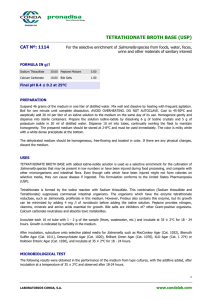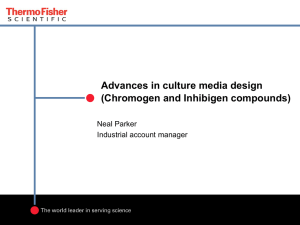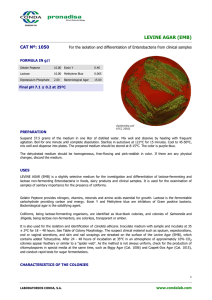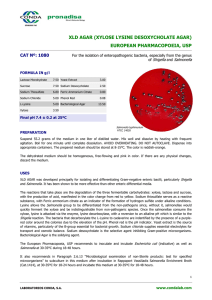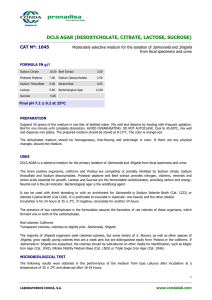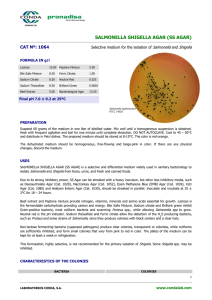SALMONELLA CHROMOGENIC AGAR CAT Nº: 1122 Salmonella spp
advertisement
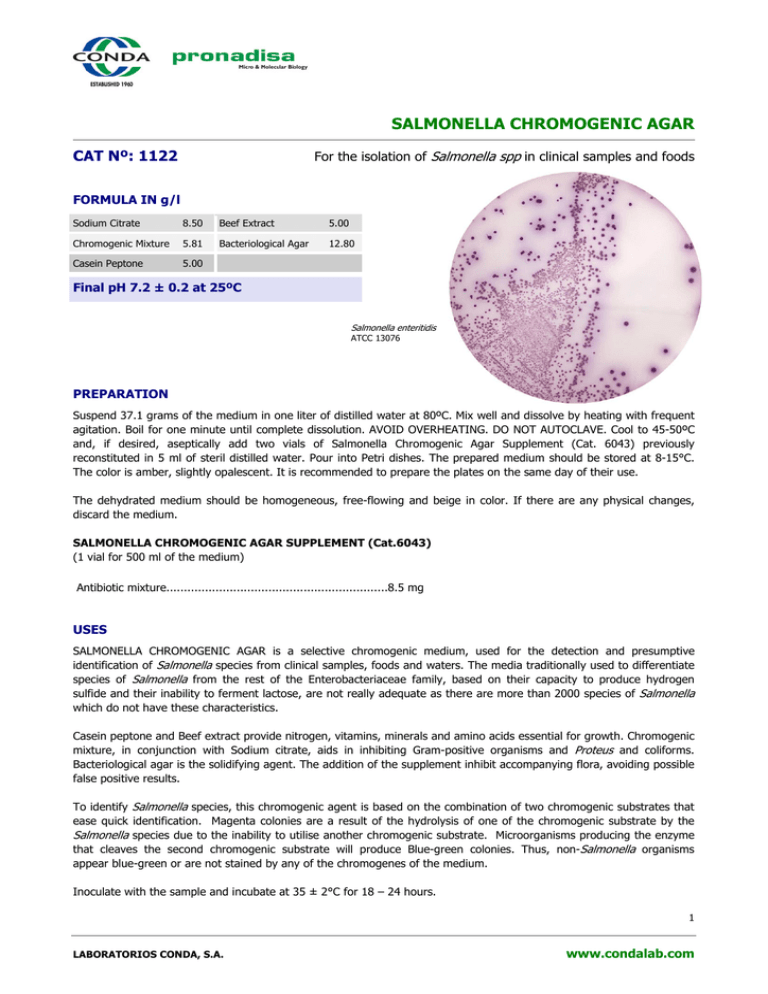
SALMONELLA CHROMOGENIC AGAR CAT Nº: 1122 For the isolation of Salmonella spp in clinical samples and foods FORMULA IN g/l Sodium Citrate 8.50 Beef Extract 5.00 Chromogenic Mixture 5.81 Bacteriological Agar 12.80 Casein Peptone 5.00 Final pH 7.2 ± 0.2 at 25ºC Salmonella enteritidis ATCC 13076 PREPARATION Suspend 37.1 grams of the medium in one liter of distilled water at 80ºC. Mix well and dissolve by heating with frequent agitation. Boil for one minute until complete dissolution. AVOID OVERHEATING. DO NOT AUTOCLAVE. Cool to 45-50ºC and, if desired, aseptically add two vials of Salmonella Chromogenic Agar Supplement (Cat. 6043) previously reconstituted in 5 ml of steril distilled water. Pour into Petri dishes. The prepared medium should be stored at 8-15°C. The color is amber, slightly opalescent. It is recommended to prepare the plates on the same day of their use. The dehydrated medium should be homogeneous, free-flowing and beige in color. If there are any physical changes, discard the medium. SALMONELLA CHROMOGENIC AGAR SUPPLEMENT (Cat.6043) (1 vial for 500 ml of the medium) Antibiotic mixture...............................................................8.5 mg USES SALMONELLA CHROMOGENIC AGAR is a selective chromogenic medium, used for the detection and presumptive identification of Salmonella species from clinical samples, foods and waters. The media traditionally used to differentiate species of Salmonella from the rest of the Enterobacteriaceae family, based on their capacity to produce hydrogen sulfide and their inability to ferment lactose, are not really adequate as there are more than 2000 species of Salmonella which do not have these characteristics. Casein peptone and Beef extract provide nitrogen, vitamins, minerals and amino acids essential for growth. Chromogenic mixture, in conjunction with Sodium citrate, aids in inhibiting Gram-positive organisms and Proteus and coliforms. Bacteriological agar is the solidifying agent. The addition of the supplement inhibit accompanying flora, avoiding possible false positive results. To identify Salmonella species, this chromogenic agent is based on the combination of two chromogenic substrates that ease quick identification. Magenta colonies are a result of the hydrolysis of one of the chromogenic substrate by the Salmonella species due to the inability to utilise another chromogenic substrate. Microorganisms producing the enzyme that cleaves the second chromogenic substrate will produce Blue-green colonies. Thus, non-Salmonella organisms appear blue-green or are not stained by any of the chromogenes of the medium. Inoculate with the sample and incubate at 35 ± 2°C for 18 – 24 hours. 1 LABORATORIOS CONDA, S.A. www.condalab.com MICROBIOLOGICAL TEST The following results were obtained in the performance of the medium from type cultures after incubation at a temperature of 35± 2ºC and observed after 18-24 hours. Microorganisms Escherichia coli ATCC 25922 Salmonella enteritidis ATCC 13076 Salmonella typhi ATCC 19430 Salmonella typhimurium ATCC 14028 Proteus vulgaris ATCC 13315 Salmonella lactose (+) Growth Colony color Partially inhibited Good Good Good Inhibited Good Blue-green Magenta Magenta Magenta Colorless Magenta BIBLIOGRAPHY Journal Clinical Microbiology, Vol. 41 nº 7 p. 3229-3232. July 2003 Robert Cassar and Paul Cuschieri. J.D. Perry, Michael Furs, Jeffrey Taylor, Et. Al. Journal Clinical Microbiology, March 1999, pag. 766-768 Vol. 37. nº 3 Gallioto di camillo, p. Et. Al. (J. Clinil Microbiol. March 1999. STORAGE 8ºC Once opened keep powdered medium closed to avoid hydration. 2ºC 2 LABORATORIOS CONDA, S.A. www.condalab.com
